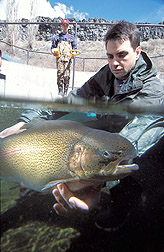Superb Trout—It's a Matter of Muscle |
|
 After egg collection, geneticist Ken Overturf returns a female brood trout into a raceway at the University of Idaho's Hagerman Fish Culture Experiment Station. Overturf and colleagues hope to breed fish that grow faster on grain-based feeds. (K10420-3) |
Some fans of rainbow trout have dubbed their favorite fish "nature's fast food." That's because it takes only a few minutes to pan-fry, grill, or microwave this tasty fish. Trout's tender, delicately flavored meat is, of course, muscle. Farm-raised trout put on muscle as they swim against the gentle, steady current that runs through the tanks, ponds, or channel-like raceways they grow up in. New studies should help researchers and rainbow trout breeders more easily single out fish that have the genetic makeup to develop more muscle more quickly. Agricultural Research Service fish geneticist Kenneth E. Overturf is doing this work with ARS and University of Idaho colleagues. Of particular interest: trout that muscle up rapidly on environmentally friendly, grain-based feeds, made from oats or barley, for instance. |
 Geneticist Ken Overturf collects immature trout, or fingerlings, in the wet lab for weight and other measurements to determine how the fish use different feeds. (K10424-1) |
Why the need for faster-growing fish with a hearty appetite for grain? First, to meet tomorrow's demand for farm-raised fish. Projections indicate that U.S. aquaculture production will have to increase by 500 percent over the next 25 years to satisfy America's needs. Second, to lessen the need to harvest ocean fish, such as menhaden or jack mackerel. Today, these species are key ingredients in feeds for their on-farm cousins. Overturf, who is with ARS' Idaho-based Small Grains and Potato Research Unit, has developed a high-tech test that sizes up a key aspect of a trout's growth. The test correlates the presence of a telltale protein—myosin—to muscle growth. Results give users a valuable new way to pinpoint trout that have, in their genetic makeup, a superior ability to convert feed into muscle. He did the studies with rainbow trout at the University of Idaho's Hagerman Fish Culture Experiment Station, about 90 miles southeast of Boise. |
 Before taking measurements, geneticist Ken Overturf (left) and technician Dan Bullock use a tag reader to identify a female brood trout. (K10423-1) |
Overturf's test provides reliable results very quickly—and doesn't harm the fish. It can be performed at a research laboratory or at any commercial lab equipped to run leading-edge tests known as real-time polymerase chain reaction (PCR) assays. The test could identify the best-performing rainbow trout as prospective super-parents, or brood-stock, of new generations. The assay is based on a key fact that researchers have known for years: myosin, the protein that's the basis of Overturf's new assay, is an important part of muscle in fish and other animals. Explains Overturf, "Trout that are active users of energy from their feed and are vigorous producers of myosin develop more muscle and grow more quickly. These fish also have less fat. That"s because they're converting a large proportion of their feed into muscle, instead of storing it as fat." But why not simply eyeball trout, using fish size as a potential indicator of continued fast growth? Because the biggest fish aren't necessarily the best. "You can't tell, from their size, which fish are the fastest at converting feed into muscle," says Overturf. But his myosin assay gives users an inside look at this aspect of a trout's genetic make-up. "Superior ability to produce myosin," he says, "is likely a gene-controlled trait." Overturf's test is the first to use newly emerging real-time PCR technology to assess how actively a rainbow trout's myosin gene is working. Real-time PCR is named for the fact that it accomplishes the many separate, time-consuming steps of conventional PCR all at once, or in what is essentially "real time." In related work, Overturf has created real-time PCR assays for analyzing nearly two dozen other gene-derived natural compounds in trout—in addition to myosin. He's done some of that work with his university colleagues. These assays find, for example, key proteins in trout that indicate a strong immune system, necessary to protect the fish from viruses or bacteria. The real-time PCR assays are a spin-off of efforts by ARS researchers at Leetown, West Virginia—and by scientists elsewhere in the United States and abroad—to locate and decipher the functions of all the genes in rainbow trout, called the trout genome. (See article above.) Discoveries about the makeup of the trout myosin gene, for instance, provided information Overturf needed to develop the myosin assay. All the new assays from the Hagerman laboratory are "an immediate, practical application of the rainbow trout genome investigations," says Lewis W. Smith, ARS National Program Leader for Aquaculture Research. The myosin assay was also based, in part, on earlier studies by Overturf and colleague Ronald W. Hardy, director of the Hagerman station. The work yielded new details about the relation of myosin to rainbow trout's prowess in converting feed to muscle. Overturf and Hardy published their findings in Aquaculture Research, a British scientific journal.—By Marcia Wood, Agricultural Research Service Information Staff. This research is part of Aquaculture, an ARS National Program (#106) described on the World Wide Web at www.nps.ars.usda.gov. Kenneth E. Overturf is in the USDA-ARS Small Grains and Potato Research Unit, c/o Hagerman Fish Culture Experiment Station, 3059F National Fish Hatchery Rd., Hagerman, ID 83332; phone (208) 837-9096, fax (208) 837-6047. "Superb Trout—It's a Matter of Muscle" was published in the June 2003 issue of Agricultural Research magazine.
|






